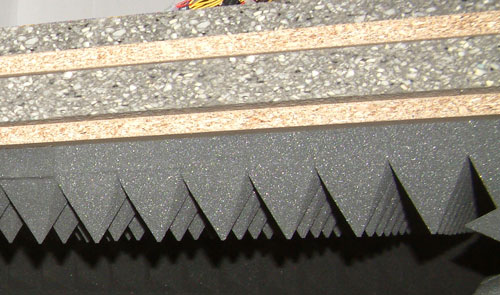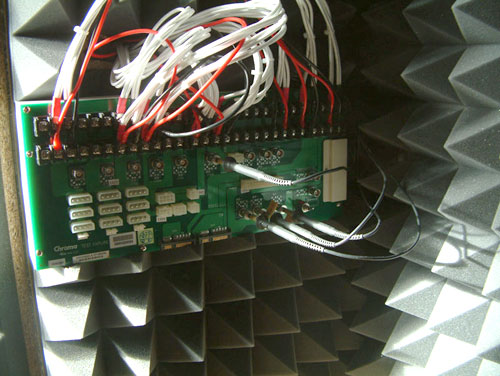Antec Signature 650W Power Supply
by Christoph Katzer on October 1, 2008 4:00 AM EST- Posted in
- Cases/Cooling/PSUs
Testing with the Chroma ATE Programmable Load

Our test equipment consists of two Chroma programmable DC Loads that enable us to test power supplies with an output of up to 1500W. The biggest advantage of the Chroma DC Loads is simply the high precision it provides. It can measure differences as small as 0.001V and 0.0001A, which will provide us with best-in-class results.
When programming the Chroma with specific amounts of load calculated according to the ATX norm, we are able to load power supplies to an exact percentage. We can now show results at every specific percentage needed. To get the best overview of a power supply, we load each unit with 10%, 20%, 50%, 80%, 100%, and 110% of the specified output. This is easy to calculate for a 1000W power supply: the 10% load is 100W and 110% load is 1100W. Remember that this is the amount of power the PSU delivers; due to inefficiencies, a power supply will actually draw more power from the wall.
Note: If you would like to know more about our testing methodology, equipment, and environment, please read our PSU testing overview.
We have added an additional 10% on the highest load to see how the units perform with overload. This test will be performed in all future reviews. The overload test is performed at room temperature as well as under more stressful conditions; to ensure we are not too cruel to the power supplies, we will keep the ambient temperature at 50°C in the stress test. Experience shows that many units can stand the overload at room temperature but will experience problems with higher temperature and overload together. Only the best-built units will survive this.

The Testing Environment
There is one flaw in testing power supplies with programmable loads while trying to measure the sound pressure levels at the same time. Because the programmable loads get very loud, there is no chance of hearing the power supply on the test stand. In order to make accurate measurements of the noise levels we needed a way to separate the test unit and the programmable loads. Our solution was to build a very thick box around the unit.

We concluded that a five-layer box with a total thickness of 6" (15cm) containing two layers of wood and three layers of special foam would suffice. It is designed as a box within a box. The inner box does not touch any part of the outer box, making it difficult for acoustic noise to pass through in the form of vibration. Each box is isolated on both sides with a layer of heavy foam that is normally used to insulate engines. On the inside we have an additional layer of 4" (10cm) thick pyramidal foam on every side of the box to eliminate the acoustic waves coming from the test object as well as we can.

To ensure a completely closed system we installed the printed circuit board that the connectors of the power supply are attached to inside the anechoic room/box. In other box designs, you would need to put all the cables through the wall. Unfortunately, that would result in the inside of the box not being fully isolated anymore. Our design keeps everything that needs to be connected inside of the box and maintains isolation.










21 Comments
View All Comments
swaaye - Tuesday, October 28, 2008 - link
With regards to 80mm vs 120mm, I think that the best PSUs often have 80mm fans seems to say something.In the PSUs I've opened that have 120s, they are obviously restricted on component height inside. PSUs with 80mm fans are also designed around the air flowing from front to back, with heatsink cooling appropriately in-lined with the flow. A bottom 120mm isn't going to make airflow remotely as orderly.
I have used a mix of 80mm and 120mm units. Some 80mm units are as quiet as the quietest 120mm units, and some 120mm units are much louder than the 80mm units. Neither has an innate advantage with noise.
ducnow - Friday, October 3, 2008 - link
I would sooner have a small fan with a direct airflow with no restrictions front to back than a bottom 120mm fan under a poorly designed "quite" PSU that has poor airflow.The only thing I wish they would have done is made a single rail edition with more modular cables.
Another thing that sucks is that we just had a PSU make over in the last 4 years with the Nvidia cards using 8 pin on the GPU and higher end boards using a 6pin. I wonder if these will still be the standard when the new core i7 boards & the new Nvidia cards come out?
DTL - Thursday, October 2, 2008 - link
Why the Ambient Temperature only 25°C ? If you are not A big white bear lives near the North Pole.Your case always 40+°C and even 50°C for my case !!! Will there any testing condition down to the earth ?strikeback03 - Friday, October 3, 2008 - link
Then I'd say the airflow in your case could use improvement. No reason for internal temps to be over 40*C. My Centurion 5 internals are around 32-35*C (P965, E6600, Tuniq, 4GB, 2 320GB HDD, 7600GT)TravisChen - Saturday, October 4, 2008 - link
We have to set the standard near the worst case, not the optimal case. Quiet a few users have their CPU fan pumping hot air directly into the PSU so even your GFX and HDD are cool your PSU is not.strikeback03 - Monday, October 6, 2008 - link
My measurements were with a thermocouple inserted through a hole in the case, not on-board sensors.HOOfan 1 - Thursday, October 2, 2008 - link
Did you miss this?"we will keep the ambient temperature at 50°C in the stress test. "
HOOfan 1 - Thursday, October 2, 2008 - link
you consider 14.5mV a bit high? When the spec is all the way up at 50mV for 3.3V and 5V. 12V rails is "a bit lower" again, are you kidding? below 9mV when the spec is all the way up to 120mV.Really, are you trying your best to seem impartial since the Antec Signature ad is the top banner ad on this site?
bob4432 - Thursday, October 2, 2008 - link
would you guys compare this to the ea-650 to see what the extra ~$150 gets us?7Enigma - Thursday, October 2, 2008 - link
That's what I'd like to see as well. There is a DRASTIC difference in price between these 2 models, and my guess is the price does not fit the increase in quality/performance. But I need to know for sure. :)